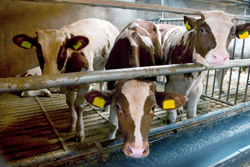Optimal floors alleviate dairy cow lameness
Lameness in dairy cows is a significant problem, not only in terms of animal health and welfare, but also as regards to productivity and competitiveness in the dairy sector. Moreover, what causes lameness and just how it develops have not been fully understood. Hence the aim of the LAMECOW project was to help lessen cases of lameness through the detection and implementation of best practices in addition to learning core biological aspects. As part of a multidisciplinary approach, highlighting causes of lameness and forming a better understanding for its prevention, an experiment was conducted in Sweden to examine flooring used for commercial herds. One of the achievements was the development of a method to assess footprint patterns of a walking cow in order to determine the degree of walking comfort on various types of surfaces. The results showed that sand ground provided the best comfort followed by rubber flooring. In contrast, the least amount of comfort was shown on slippery concrete surfaces. As regards to standing, rubber flooring was again preferable to concrete by as much as 70%. Furthermore it was found that rubber combined with mastic asphalt helped to lessen the wear rate and level of injury to claws. This provides the optimal solution with the most benefits including healthy claw growth.







